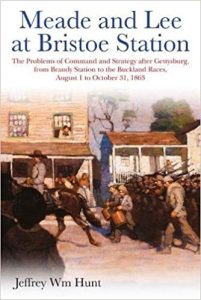Book Review: “Meade and Lee at Bristoe Station”
Here’s an understatement: there have been a lot of books written about the American Civil War. Hundreds of them about Gettysburg; thousands about Lincoln; biographies, campaign monographs, and studies about the home front. You name it, there’s probably a plethora of books about it. And yet, think, for a moment, about the literature available pertaining to the operations of the Army of the Potomac and the Army of Northern Virginia between the end of the battle of Gettysburg and the beginning of the battle of the Wilderness ten months later. Specifically, what is available to a reader about the battle of Bristoe Station? The answer is not much.
There was a book published in 1987 by William Henderson, part of a well-received series, but one that is now out of print and expensive to boot. There’s a 2010 self-published monograph by Adrian Tighe. Emerging Civil War has a book available about the campaign, and Bradley Gottfried has published one of his well-known map collections regarding the battle. And that’s about it. In the vast, vast libraries there are, essentially, these four well-known books about the Bristoe Station Campaign. To put it differently, there’s plenty of space for other authors to add to the campaign’s knowledge, and that is exactly what Jeffrey Hunt has done with his own volume about the chaotic movements in the fall of 1863.
Because of the relative dearth of material, there can sometimes be the perception from the general public that, after the bloodletting of the battle of Gettysburg, both armies went into hibernation until May 1864. This is where Hunt steps in with his series, a well-written overview of the armies, both at the operational and tactical level. His first book Meade and Lee after Gettysburg, took the armies up to July 31, 1863 (Emerging Civil War reviewed that title here). Hunt picks up where he left the story, beginning his narrative of Meade and Lee at Bristoe Station on August 1.
What follows is nearly 450 pages of some of the best material available on the forgotten campaigning of 1863. Hunt clearly has a grasp of what happened during those seemingly forgotten weeks and months, and his writing style is clear and easy to understand.
No matter what one is looking for regarding the Bristoe Station Campaign, they’re likely to find it within Hunt’s pages. He starts at the army level, detailing both armies’ overall problem in the late summer and early fall of 1863. For George G. Meade, that meant logistical quagmires that found his army low on supplies, and the additional problem of having to send manpower to places like New York City to suppress the famed Draft Riots. For Robert E. Lee, it meant having to replace nearly a third of his officer corps, having left so many of them dead and wounded back in Pennsylvania. Embarrassed, Lee submitted his resignation in August. As Hunt gets to the core of his book, these are the two commanders—exhausted, overworked, and anxious—that are going to lead their armies back into the fray.
With the campaign getting underway, Lee hoped for a repeat of his wildly successful Second Manassas Campaign, pushing “those people” as he called them, away from the Rapidan River and closer into the environs of Washington, D.C. The campaign, laid out in Hunt’s prose, is easy to follow along.
Historians and aficionados of cavalry operations during the Civil War will find much to their liking within Hunt’s book. He carefully narrates, describes, and analyzes the plethora of engagements between the armies’ mounted arms. What has the potential to be confusing and hard to follow, as descriptions of cavalry fighting can sometimes succumb to, Hunt instead keeps clear through the use of multiple maps scattered throughout his text. They are a valuable asset to have as one makes their way through his chapters.
By the middle of October, the armies were near Bristoe Station, a railway stop along the Orange & Alexandria Railroad, and Hunt’s narrative follows close behind. Just as followers of the cavalry will enjoy the first half of Hunt’s book, those who revel in studying the infantry of the Civil War will find much to their liking in Hunt’s treatment of the battle of Kettle Hill, and the climatic battle of Bristoe Station. Lt. Gen. A.P. Hill threw soldiers of his corps into a waiting force of Federals, who used the protection of the railroad to blast the oncoming Confederate attacks to pieces. Hunt’s descriptions of these actions prove that, far from hibernating between Gettysburg and the Wilderness, the competing armies were locked in battles that surely lacked no drama or movement.
Hunt’s narrative ends with the armies separating as the campaign concluded. Hunt analyzes the end of the campaign just as thoroughly as he did the beginning of it, and he makes the point that neither commander was satisfied with what had been accomplished over the preceding weeks. It was now the end of October, and as far as Meade was concerned, there was still plenty of good roads and good weather to campaign with. Hunt’s series will follow along as the armies close once more around Rappahannock Station, and, eventually, the trenches of Mine Run. If those soon-to-be-published volumes are as good as the first two Hunt has produced, they will be fine works indeed.
Jeffrey Wm. Hunt, Meade and Lee at Bristoe Station: The Problems of Command and Strategy After Gettysburg from Brandy Station to the Buckland Races, August 1 to October 31, 1863.
Savas Beatie, 2019.
453 Pages main text/ 471 Pages total
Footnotes, Bibliography, Index.


Thank you for taking the time to review my book! I appreciate the kind words and hope you like the next two volumes in the series just as much.